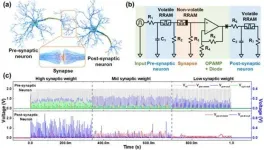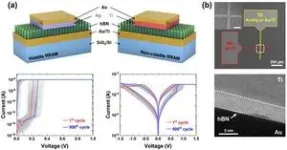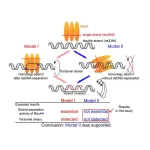(Press-News.org) With the emergence of new industries such as artificial intelligence, the Internet of Things, and machine learning, the world's leading companies are focusing on developing next-generation artificial intelligence semiconductors that can process vast amounts of data while consuming energy efficiently. Neuromorphic computing, inspired by the human brain, is one of them. As a result, devices that mimic biological neurons and synapses are being developed one after another based on emerging materials and structures, but research on integrating individual devices into a system to verify and optimize them is still lacking. In order for large-scale artificial neural network hardware to become practical in the future, it is essential to integrate artificial neuron and synaptic devices, and it is necessary to reduce mass production costs and energy usage by fabricating devices with the same materials and structures.
A team led by Dr. Joon Young Kwak of the Center for Neuromorphic Engineering at the Korea Institute of Science and Technology (KIST) announced that they have implemented an integrated element technology for artificial neuromorphic devices that can connect neurons and synapses like "Lego blocks" to construct large-scale artificial neural network hardware.
The team fabricated vertically stacked memristor devices using hBN, a two-dimensional material that is advantageous for high integration and ultra-low power implementation, to demonstrate biological neurons and synapses characteristics. Since the team designed artificial neuron and synaptic devices with the same material and the same structure, unlike conventional silicon CMOS-based artificial neural imitation devices with complex structures using multiple devices, the devices developed by the team have secured ease of process and network scalability, paving the way for the development of large-scale artificial neural network hardware.
By integrating and connecting the developed devices, the team also successfully implemented the "neuron-synapse-neuron" structure, the basic unit block of an artificial neural network, in hardware to demonstrate spike signal-based information transmission, which is how the human brain works. By experimentally verifying that the modulation of spike signal information between two neurons can be adjusted according to the synaptic weights of the artificial synaptic device, the researchers showed the potential of using hBN-based emerging devices for low-power, large-scale AI hardware systems.
"Artificial neural network hardware systems can be used to efficiently process vast amounts of data generated in real-life applications such as smart cities, healthcare, next-generation communications, weather forecasting, and autonomous vehicles," said KIST's Dr. Joon Young Kwak, explaining the significance of the research achievement. "It will help improve environmental issues such as carbon emissions by significantly reducing energy usage while exceeding the scaling limits of existing silicon CMOS-based devices."
###
KIST was established in 1966 as the first government-funded research institute in Korea. KIST now strives to solve national and social challenges and secure growth engines through leading and innovative research. For more information, please visit KIST’s website at https://eng.kist.re.kr/
The research was funded by the Ministry of Science and ICT (Minister Jong-Ho Lee)'s Next Generation Intelligent Semiconductor Technology Development (Device) Project (2021M3F3A2A01037738) and KIST's Institutional Program and was published in the international journal Advanced Functional Materials (IF: 19.0, JCR(%): 4.2) online on November 5.
END
Implement artificial neural network hardware systems by stacking them like "neuron-synapse-neuron" structural blocks
Implementing the 'neuron-synapse-neuron' basic unit structure in hardware for high-performance, low-power neuromorphic computing. Same material, same structure for processability and network scalability
2024-01-22
ELSE PRESS RELEASES FROM THIS DATE:
The megalodon was less mega than previously believed
2024-01-22
A new study shows the Megalodon, a gigantic shark that went extinct 3.6 million years ago, was more slender than earlier studies suggested. This finding changes scientists’ understanding of Megalodon behavior, ancient ocean life, and why the sharks went extinct.
The Megalodon or megatooth shark is typically portrayed as a super-sized monster in popular culture, with recent examples in the sci-fi films “The Meg” (2018) and “Meg 2: The Trench” (2023). Previous studies assume that the shark likely reached lengths of at least 50 feet and possibly as much as 65 feet.
However, the Megalodon is largely known only from its teeth and vertebrae in the ...
Slender shark: Study finds Megalodon was not like a gigantic great white shark
2024-01-22
CHICAGO — A new scientific study shows that the prehistoric gigantic shark, Megalodon or megatooth shark, which lived roughly 15-3.6 million years ago nearly worldwide, was a more slender shark than previous studies have suggested.
Formally called Otodus megalodon, it is typically portrayed as a super-sized, monstrous shark in novels and sci-fi films, including “The Meg.” Previous studies suggest the shark likely reached lengths of at least 50 to 65 feet (15 to 20 meters). However, ...
New criteria for sepsis in children based on organ dysfunction
2024-01-21
Clinician-scientists from Ann & Robert H. Lurie Children’s Hospital of Chicago were among a diverse, international group of experts tasked by the Society of Critical Care Medicine (SCCM) with developing and validating new data-based criteria for sepsis in children. Sepsis is a major public heath burden, claiming the lives of over 3.3 million children worldwide every year. The new pediatric sepsis criteria – called the Phoenix criteria – follow the paradigm shift in the recent adult criteria that define sepsis as severe ...
Development and validation of the Phoenix criteria for pediatric sepsis and septic shock
2024-01-21
About The Study: In this international, multicenter, retrospective cohort study including more than 3.6 million pediatric encounters, a novel score, the Phoenix Sepsis Score, was derived and validated to predict mortality in children with suspected or confirmed infection. The new criteria for pediatric sepsis and septic shock based on the score performed better than existing organ dysfunction scores and the International Pediatric Sepsis Consensus Conference criteria.
Authors: Tellen D. Bennett, M.D., M.S., of the University of Colorado School of Medicine and Children’s Hospital Colorado in Aurora, is the corresponding author.
To access the ...
International consensus criteria for pediatric sepsis and septic shock
2024-01-21
About The Study: The Phoenix sepsis criteria for sepsis and septic shock in children were derived and validated by the international Society of Critical Care Medicine Pediatric Sepsis Definition Task Force using a large international database and survey, systematic review and meta-analysis, and modified Delphi consensus approach. A Phoenix Sepsis Score of at least 2 identified potentially life-threatening organ dysfunction in children younger than 18 years with infection, and its use has the potential to improve clinical care, epidemiological assessment, and research in pediatric sepsis and septic shock around the world.
Authors: R. Scott ...
CU researchers unveil modernized criteria for pediatric sepsis and septic shock
2024-01-21
An international research team led by Tell Bennett, MD, MS, professor of biomedical informatics and pediatric critical care at the University of Colorado School of Medicine, released new diagnostic criteria for sepsis in children this week, marking the first update to the pediatric sepsis definition in nearly two decades.
The updated criteria, presented at the 2024 Critical Care Congress of the Society for Critical Care Medicine (SCCM), will be utilized ...
A computerized decision support system significantly reduces high-risk drug combinations in Intensive Care patients
2024-01-21
A recent multicentre study led by Amsterdam UMC and conducted in nine Dutch Intensive Care Units (ICUs) has shown that tailoring a computerised decision support system (CDSS) to the ICU environment significantly reduced the number of high-risk drug combinations administered to ICU patients. It also improved monitoring ICU patients when avoiding such combinations was not possible, and reduced the length of patients’ stay in the ICU. This study is published today in The Lancet.
"Not more, but fewer and more relevant alerts by a CDSS make such a system more valuable for healthcare providers and patients," says Amsterdam ...
Scientists unravel key steps in the road to DNA repair
2024-01-20
Tokyo, Japan – Researchers from Tokyo Metropolitan University have been studying DNA repair by homologous recombination, where the RecA protein repairs breaks in double-stranded DNA by incorporating a dangling single-strand end into intact double strands, and repairing the break based on the undamaged sequence. They discovered that RecA finds where to put the single strand into the double helix without unwinding it by even a single turn. Their findings promise new directions in cancer research.
Homologous recombination (HR) is a ubiquitous biochemical process shared across all living things, including animals, plants, fungi, and bacteria. As we go about our daily ...
Study identifies new PD-1 immune checkpoint mechanism promoting merkel cell carcinoma growth
2024-01-19
Programmed cell death 1 (PD-1) is an important target for immune checkpoint inhibitor therapies that block its signaling and boost T-cell activity. PD-1 inhibitors have been approved for treating various types of cancer.
But PD-1 functions can vary between different cell and cancer types, either promoting or suppressing disease progression. Merkel cell carcinoma (MCC), a rare and aggressive form of skin cancer, responds well to immune checkpoint inhibitor therapy. However, it was previously unknown if MCC cells express PD-1 themselves, and unclear how exactly cancer cell-intrinsic ...
Vanderbilt chemist Ben Brown awarded $2.375M to develop nonaddictive painkillers with AI
2024-01-19
When Ben Brown, research assistant professor of chemistry, thinks about the opioid epidemic, he views the problem on a molecular level. Painkillers used legitimately in medicine, such as oxycodone, are highly addictive, but better understanding of how their molecules interact with proteins in the body could lead to the formulation of nonaddictive alternatives, he said.
In May, the National Institute on Drug Abuse awarded Brown $1.5 million over five years to further his work in this area. Brown, faculty affiliate of the Vanderbilt Center for Addiction Research and the Center for Applied Artificial Intelligence in Protein Dynamics, is developing artificial intelligence that ...
LAST 30 PRESS RELEASES:
Retail therapy fail? Online shopping linked to stress, says study
How well-meaning allies can increase stress for marginalized people
Commercially viable biomanufacturing: designer yeast turns sugar into lucrative chemical 3-HP
Control valve discovered in gut’s plumbing system
George Mason University leads phase 2 clinical trial for pill to help maintain weight loss after GLP-1s
Hop to it: research from Shedd Aquarium tracks conch movement to set new conservation guidance
Weight loss drugs and bariatric surgery improve the body’s fat ‘balance:’ study
The Age of Fishes began with mass death
TB harnesses part of immune defense system to cause infection
Important new source of oxidation in the atmosphere found
A tug-of-war explains a decades-old question about how bacteria swim
Strengthened immune defense against cancer
Engineering the development of the pancreas
The Journal of Nuclear Medicine ahead-of-print tip sheet: Jan. 9, 2026
Mount Sinai researchers help create largest immune cell atlas of bone marrow in multiple myeloma patients
Why it is so hard to get started on an unpleasant task: Scientists identify a “motivation brake”
Body composition changes after bariatric surgery or treatment with GLP-1 receptor agonists
Targeted regulation of abortion providers laws and pregnancies conceived through fertility treatment
Press registration is now open for the 2026 ACMG Annual Clinical Genetics Meeting
Understanding sex-based differences and the role of bone morphogenetic protein signaling in Alzheimer’s disease
Breakthrough in thin-film electrolytes pushes solid oxide fuel cells forward
Clues from the past reveal the West Antarctic Ice Sheet’s vulnerability to warming
Collaborative study uncovers unknown causes of blindness
Inflammatory immune cells predict survival, relapse in multiple myeloma
New test shows which antibiotics actually work
Most Alzheimer’s cases linked to variants in a single gene
Finding the genome's blind spot
The secret room a giant virus creates inside its host amoeba
World’s vast plant knowledge not being fully exploited to tackle biodiversity and climate challenges, warn researchers
New study explains the link between long-term diabetes and vascular damage
[Press-News.org] Implement artificial neural network hardware systems by stacking them like "neuron-synapse-neuron" structural blocksImplementing the 'neuron-synapse-neuron' basic unit structure in hardware for high-performance, low-power neuromorphic computing. Same material, same structure for processability and network scalability






